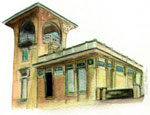|
Grottammare is named after the toponym “Grotte a mare”
 (“Caves
to the sea”) that refers to the natural caves opening
from the east side of the ancient town’s hill, once
lapped by sea waves. (“Caves
to the sea”) that refers to the natural caves opening
from the east side of the ancient town’s hill, once
lapped by sea waves.
On the other side the tourist history of Grottammare as
a famous health and seaside resort, starts in the
seventeenth-century, when noble families of the period
used to spend here their holiday-time.
The development of the urban centre along the seaside
starts in the eighteenth-century, and it has been
possible for more favourable social and economic
conditions on one side and because of the continuous
sea-withdrawal on the other one.
In the nineteenth-century Grottammare was a recommended
place by many of the main doctors of the period; it was
an ideal town for having convalescence and treatments
for respiratory and dermatological diseases.
Some of the most famous personalities that chose
Grottammare for a stay have been Girolamo Bonaparte, the
younger brother of Napoleon, and the famous musician
Franz Liszt who declared in the summer of 1868:
“I will always keep in my mind the weeks spent in
Grottammare as the best and sweetest of my life”.
 LThe
charming
villini Liberty,
small villas in Art Noveau style close to the seaside,
marked out the beginning of the twentieth-century, and
still today are one of the artistic greatness achieved
by Grottammare. LThe
charming
villini Liberty,
small villas in Art Noveau style close to the seaside,
marked out the beginning of the twentieth-century, and
still today are one of the artistic greatness achieved
by Grottammare.
In the following years Grottammare has been further
adorned with a lot of palms and oleanders along the
promenade, wide pineta near the beach and, starting from
thirties, the first facilities for entertainment and
spare time like the Kursaal, a famous nightclub that
livened up sixties nights of the whole Riviera
Adriatica: today it’s a museum. |





